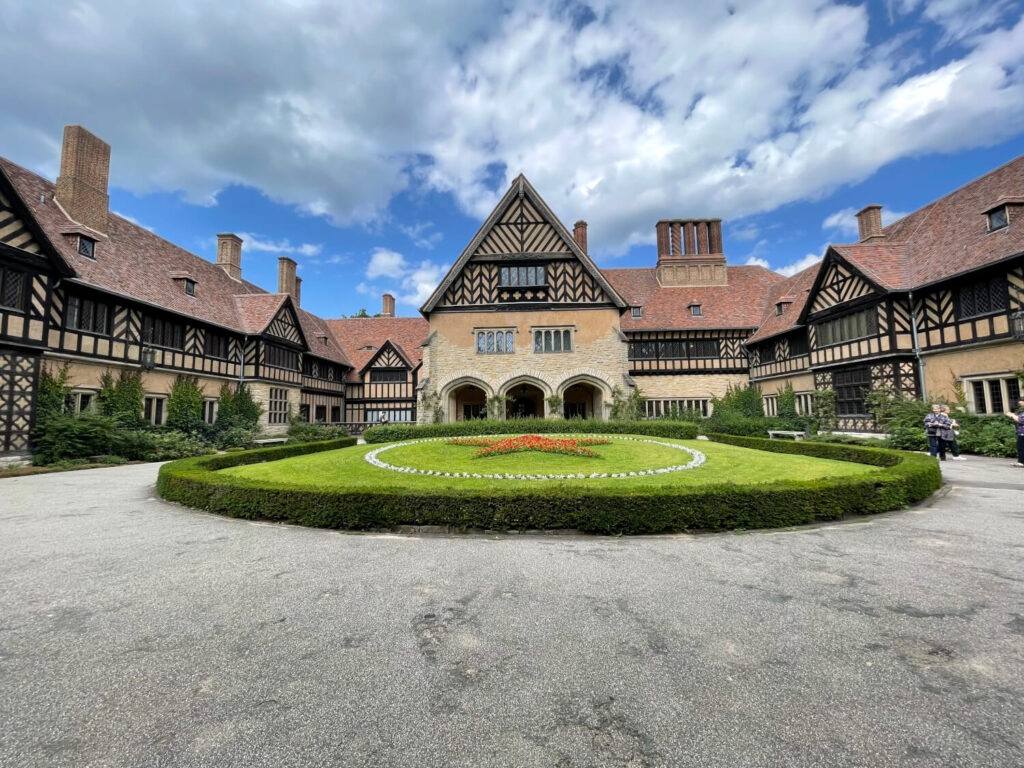We visited Potsdam and the Babelsberg suburb for a weekend, which we unfortunately had to cancel previously on our trip through Germany due to time constraints. So now we took the time to visit the Babelsberg Film Park on a Saturday and Potsdam with its Prussian palaces and gardens on the subsequent Sunday. Rarely have I been so overwhelmed by sights in Germany as I was in Potsdam on that Sunday. But read for yourself.
Filmpark Babelsberg
We strategically chose our accommodation for the weekend in Kleinmachnow and stayed at the B&B Hotel Berlin-Dreilinden*. The hotel met all our requirements in terms of price, location, (free) parking, breakfast and cleanliness. We would certainly recommend it for further visits to the east. This laid the foundations for the weekend and we set off to explore.






Babelsberg, as a district of Potsdam, is characterized by its rich film history. Known for Studio Babelsberg, one of the oldest film studios in the world, the area has a strong connection to film production. In addition to historic film sets and production facilities, Babelsberg also offers green parks, avenues and stylish villas that make the district an attractive place to live. The synthesis of culture, history and a touch of glamor makes Babelsberg a unique and fascinating place.
As a film fan, it was high time to visit the “Hollywood of Germany”. Filmpark Babelsberg is a unique attraction for film enthusiasts. As part of Studio Babelsberg, the Filmpark offers insights behind the scenes of film production. Visitors can explore film sets, take part in studio tours and experience interactive shows. With attractions such as stunt shows, a film museum and hands-on activities, the Filmpark offers an entertaining mix of film history and entertainment for the whole family. Here, visitors can experience the magic of film up close and immerse themselves in the world of film production. Secure your tickets online in advance and plan at least three hours for your visit.
Prussian palaces and gardens in Potsdam and Brandenburg
We spent the evening in the darn good Restaurant Korfu in Stahnsdorf and enjoyed the food and service the Greek way. We also booked a combined ticket for the palaces and gardens in Potsdam for the next day. A wise decision, as we realized the next day.
The combined ticket gives you the opportunity to visit all the palaces in Potsdam. Which is of course not possible in one day, so we had to cut back. We therefore decided to focus on three main areas: Sanssouci Park, the New Garden and Babelsberg Park with their respective magnificent buildings.
Sanssouci Park
This park is probably the best known with its star, Sanssouci Palace. Sanssouci Palace is the most famous palace of the Prussian King Frederick II. Built in the 18th century and influenced by the French, the palace impresses with its elegant architecture and magnificent gardens. Sanssouci, which means “without worries”, was the king’s personal retreat and is now a UNESCO World Heritage Site. The palace embodies the royal splendor and cultural richness of Prussian heritage.






The Orangery Palace, also located in Sanssouci Park, is an impressive architectural jewel. It was built in the 19th century under King Frederick William IV in the Italian Renaissance style. The palace was designed as a greenhouse for exotic plants and to house citrus trees.
The Chinese House can also be found in Sanssouci Park and is a fascinating example of the exotic taste of 18th century Europe. It was built between 1755 and 1764 under the direction of King Frederick the Great. The Chinese House is a symbol of the influence of Far Eastern aesthetics in 18th century European architecture and contributes to the unique cultural diversity of Sanssouci.
Potsdam – the splendor of the past
We continued our walk through the surreal park grounds of Sanssouci and headed west towards the New Palace. While we had been impressed by the buildings up until then, we were now overwhelmed by the sight of this magnificent building – and we were only at the back of the building! After quickly showing our tickets and registering for the next tour, we immersed ourselves in the sprawling luxury of the past.






The New Palace was built by order of King Frederick II (Frederick the Great) during the 18th century. It served as a residence and representative palace and was conceived as a kind of “peace palace” after the Seven Years’ War. The architecture of the New Palace is impressive with its mixture of baroque and rococo elements. The palace has magnificent interiors and opulent galleries. It is often regarded as one of the outstanding examples of rococo architecture in Germany and leaves every visitor in awe.
New Garden
The second park was the New Garden to the north-east of Sanssouci. We reached it by car in just a few minutes. Cecilienhof Palace was our highlight here, after we had refreshed ourselves in the Meierei Potsdam brewery and restaurant. We walked through Cecilienhof Palace with an audio guide and it was only once we were inside that we realized that this place might be quite well-known.




Cecilienhof Palace is a historic building that was built between 1914 and 1917 for Crown Prince Wilhelm of Prussia. The palace is known for its unusual Tudor architecture and was named after the daughter of the last German emperor, Crown Princess Cecilie. Cecilienhof gained worldwide fame as the site of the Potsdam Conference in 1945, where the Allies negotiated the post-war settlement. Today, the palace is a memorial and museum documenting the history of this important conference and life in the German Empire.
Babelsberg Park
The last stop on our Potsdam exploration was Babelsberg Park. The palace belonging to it is Babelsberg Palace, which unfortunately was not accessible. Babelsberg Palace is an elegant neo-Gothic building that was built in the 19th century for the Prussian Prince Wilhelm, later Emperor Wilhelm I, and his wife Augusta. Designed by architect Karl Friedrich Schinkel, the palace is characterized by its romantic architecture and picturesque location on the shores of Lake Griebnitzsee. Babelsberg Palace served as a royal residence and was later used by Kaiser Wilhelm II, among others.
Conclusion
Our weekend visit to Potsdam was simply enchanting and exceeded all expectations. The historic atmosphere of the city, paired with magnificent palaces and idyllic parks, created a fantastic backdrop that enchanted us. From a stroll through the magnificent gardens of Sanssouci to a visit to the picturesque Cecilienhof Palace, every experience was a journey through history. The cozy cafés and restaurants not only offered delicious food, but also a relaxing break amidst the charming cityscape. Potsdam really impressed us with its diversity of culture, history and nature and provided us with an unforgettable weekend.
Got a taste for the East? Then continue here with Leipzig.
In Potsdam, the Babelsberg film park and the palaces and parks are well worth a visit.
Potsdam is characterized by its fascinating mix of history, culture and natural beauty. The city is world-famous for its impressive palaces and gardens, in particular the ensemble of Sanssouci, which is a UNESCO World Heritage Site.
You should plan at least one weekend.
*The links to Booking.com contained in this article are so-called affiliate links. With these links, tripination.com receives a commission for mediated purchases. This does not increase the price for the customer.
